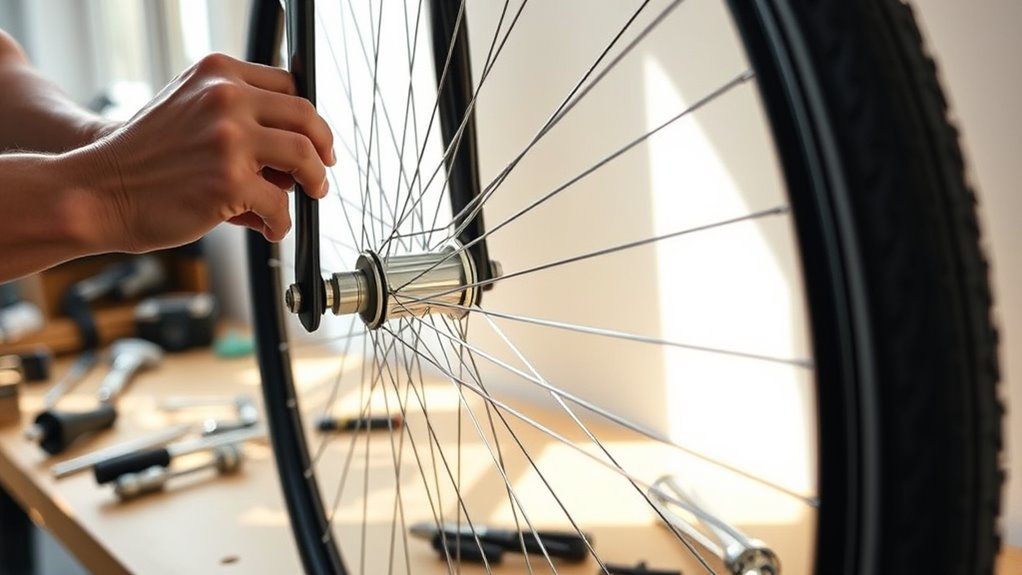To true a bicycle wheel at home, start by gathering your tools—spoke wrenches, tire levers, and a pump—and check your spokes for tension issues. Spin the wheel to identify wobble or misalignment, then loosen spokes on the affected side with a wrench. Carefully tighten or loosen spokes to straighten the rim, checking frequently. For more tips on achieving a perfect wheel, continue to explore the process in detail.
Key Takeaways
- Gather necessary tools like a spoke wrench, tire levers, and a truing stand or marker for measuring rim deviation.
- Spin the wheel to identify wobble and check rim alignment with brake pads or a ruler.
- Loosen or tighten spokes on the affected side to correct rim alignment, maintaining even tension.
- Make incremental adjustments, frequently spinning the wheel to monitor progress and avoid overcorrecting.
- Perform final checks on brake clearance, tire pressure, and wheel spin to ensure a smooth, true ride.
Gathering the Necessary Tools and Materials
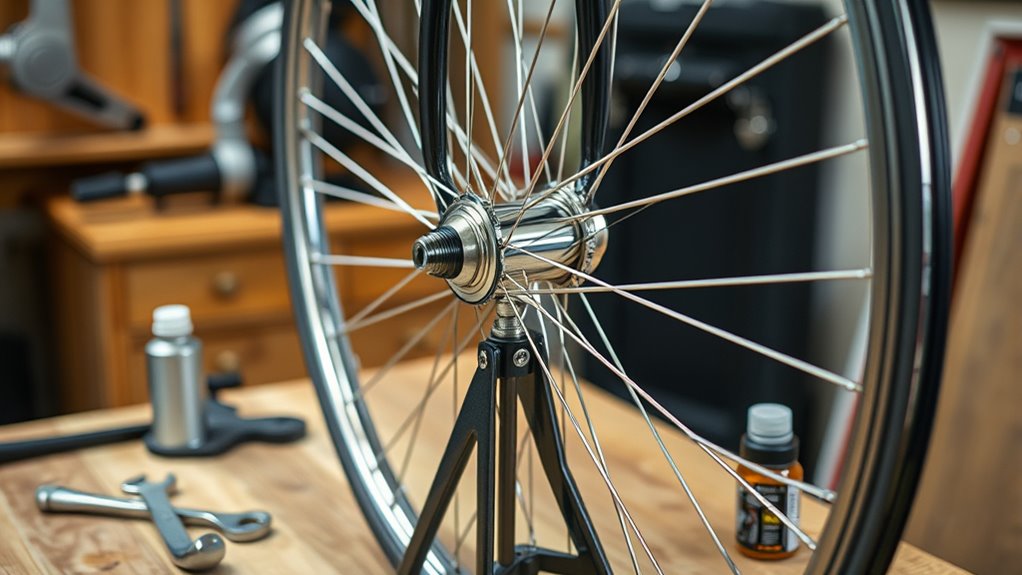
Before you begin repairing your bicycle, it’s essential to gather all the necessary tools and materials. Start with a tools checklist that includes a spoke wrench, tire levers, a pump, and a truing stand if available.
Gather all essential tools and materials before starting your bicycle repair for a smooth and efficient process.
You’ll also need materials like replacement spokes, rim tape, and lubricants. Proper material preparation helps streamline the repair process and guarantees you don’t forget anything mid-task.
Check your supplies to confirm everything is in good condition and within reach. Organize your tools on a clean surface for easy access.
Having everything ready prevents interruptions and makes the repair smoother. Remember, a well-prepared workspace minimizes frustration and helps you focus on truing the wheel accurately.
Preparing thoroughly is key to a successful and efficient bicycle repair.
Assessing the Wheel for Wobbles and Misalignment
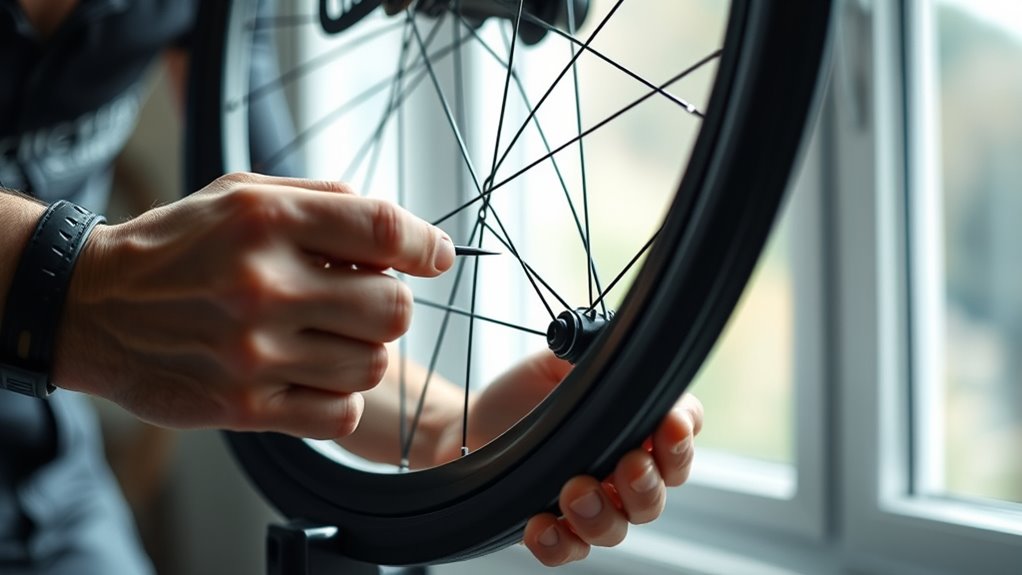
Once you’ve gathered your tools and materials, it’s time to evaluate the wheel’s condition. Spin the wheel and watch the rim carefully. Look for side-to-side wobbles or uneven rim alignment, which indicate misalignment. Keep an eye on the rim’s position relative to the brake pads; if it’s rubbing or clearances are uneven, the rim may be misaligned. Feel for inconsistencies in spoke tension by gently pressing on the spokes with your fingers; loose or overly tight spokes can cause wobbling. Use a ruler or truing stand if available to measure rim deviation. Identifying these issues early helps you determine which spokes need adjusting. Additionally, inspecting the spoke tension helps ensure the wheel remains true and durable over time. Properly tensioned spokes are essential for a safe and reliable ride, especially considering the importance of local laws and regulations that may affect your bicycle use. Ensuring that your wheel is properly wheel maintenance can prevent further damage and extend its lifespan. Accurate assessment ensures that your wheel will be properly trued, providing a smooth ride and preventing further damage.
Loosening the Spokes and Preparing for Truing

To begin loosening the spokes and preparing your wheel for truing, start by identifying the spokes that are out of alignment or causing wobbling. Check for uneven spoke tension, which affects wheel alignment. Use a spoke wrench to carefully loosen the spokes on the wobbling side, reducing tension to match the others. This step helps create a baseline for trueing. Keep the following in mind:
| Spoke Tension | Wheel Alignment |
|---|---|
| Too tight | Causes wobble |
| Too loose | Leads to misalignment |
| Proper tension | Ensures stability |
Loosening selected spokes allows you to adjust tension evenly during the truing process. Take your time and ensure each spoke is sufficiently loosened without removing tension entirely.
Adjusting the Spokes to Correct the Wheel’s Shape
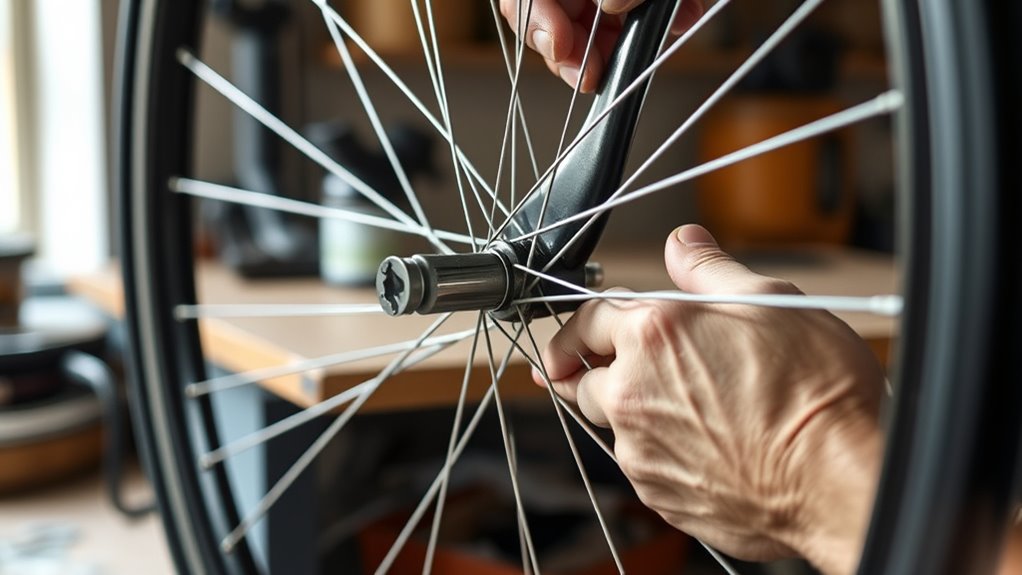
When adjusting the spokes to correct the wheel’s shape, you need to carefully tighten or loosen individual spokes to realign the rim. Start by identifying areas where the rim is out of true, then focus on spokes on that side. Increasing spoke tension on one side pulls the rim in that direction, while loosening tension allows it to move back. Check rim alignment frequently by spinning the wheel and observing deviations. Maintain even spoke tension across the wheel to ensure stability and prevent future issues. Use a spoke wrench to make small adjustments, turning clockwise to tighten and counterclockwise to loosen. Proper spoke tension creates a balanced wheel with correct rim alignment, essential for a smooth, safe ride. Ensuring consistent tension also helps preserve the contrast ratio of the wheel, contributing to overall durability and performance.
Final Checks and Ensuring a Smooth Ride
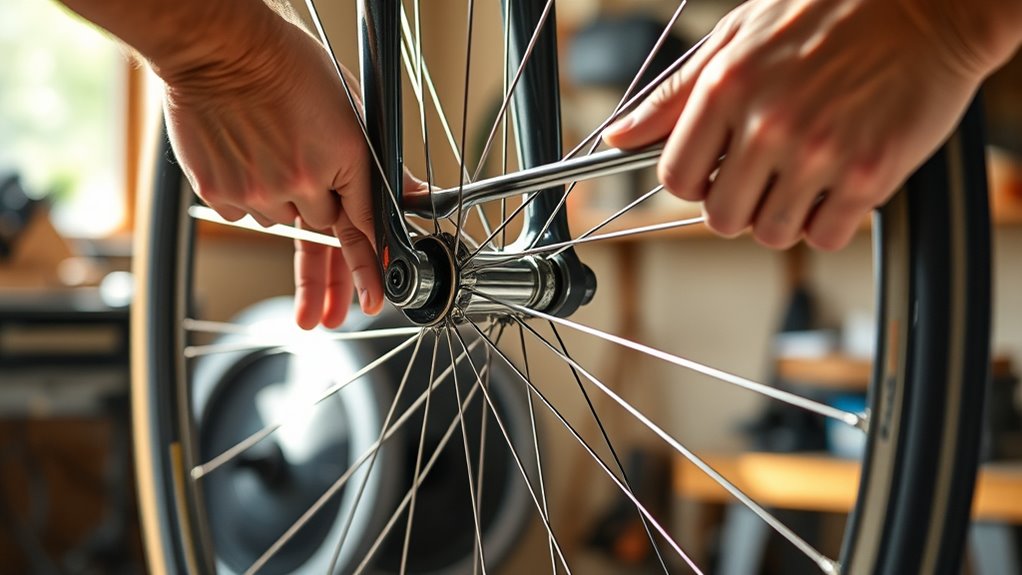
Before riding your bicycle after making adjustments, it’s important to perform final checks to guarantee everything is secure and functioning properly.
First, inspect the brake alignment to ensure the pads contact the rim evenly, preventing uneven wear and ensuring effective stopping power. Proper brake alignment is crucial for safety and efficiency.
Second, check the tire pressure; proper pressure improves ride quality, reduces flats, and minimizes rolling resistance. Adequate tire pressure also helps in preventing damage to your wheels and tires. Maintaining optimal tire pressure can also extend the lifespan of your tires and improve overall performance. Regularly monitoring your bike maintenance routines helps keep your bicycle in top condition.
Third, give your wheel a gentle spin to confirm it’s true and spins smoothly without wobbling. Ensuring your wheel is properly aligned enhances overall riding comfort and safety.
Additionally, double-check that all nuts and quick releases are tight. This way, you prevent any unexpected issues during your ride.
Taking these simple steps helps ensure a safe, comfortable, and efficient ride every time.
Proper brake alignment and tire pressure are key to a smooth, trouble-free cycling experience.
OUTRAGEOUS ANTICS of some celebrities remind us that even in the spotlight, maintaining safety and proper equipment checks is essential for a smooth ride.
Frequently Asked Questions
How Often Should I True My Bicycle Wheels?
You should true your bicycle wheels regularly to guarantee smooth rides and prevent damage. During wheel inspection, check for wobbles and uneven spoke tension.
If you notice any wobbling or loose spokes, it’s time to true the wheel. Generally, inspect your wheels every few months or after rough rides.
Keeping spoke tension balanced helps maintain wheel integrity, so make truing a routine part of your bike maintenance.
Can I True a Wheel Without Professional Tools?
You might wonder if you can true a wheel without professional tools, and the answer is yes, but with caution. Adjusting spoke tension and rim alignment requires a steady hand and patience.
While you can attempt it at home, beware of over-tightening spokes or misaligning the rim, which can cause further damage. For minor tweaks, simple tools like a spoke wrench and visual checks can do the trick.
But sometimes, professional help guarantees safety and precision.
What Are Signs That My Wheel Needs Truing?
You’ll notice your wheel needs truing if you see rim wobble or if the bike feels unstable while riding. Check spoke tension—loose spokes can cause the rim to wobble and affect ride quality.
If the wheel isn’t spinning true or you hear rubbing or clicking sounds, it’s time to true your wheel. Regularly inspecting these signs helps prevent further damage and keeps your ride smooth.
How Do I Prevent Spoke Breakage During Truing?
Think of your wheel as a tightrope walker balancing perfectly. To prevent spoke breakage during truing, you must keep the spoke tension even, like the tightrope’s tautness. Avoid over-tightening or loosening spokes suddenly, which throws off wheel alignment.
Regularly check tension, and make small, gradual adjustments. This careful approach guarantees your wheel stays strong and true, just like a confident tightrope walker’s steady step.
Is It Safe to Ride on a Slightly Out-Of-True Wheel?
Riding on a slightly out-of-true wheel can be safe if you consider safety and wheel stability. Small deviations may not affect performance immediately, but they can worsen over time, risking further damage or accidents.
Check your wheel regularly, and if the wobble worsens or affects ride quality, it’s best to true it properly. Always prioritize safety, and avoid pushing your bike too hard on a misaligned wheel.
Conclusion
By mastering wheel truing at home, you can save money and keep your bike running smoothly. For example, imagine noticing a wobble after a rough ride; with the right tools and patience, you quickly straighten the wheel yourself. Regular maintenance prevents costly repairs and extends your bike’s lifespan. So next time your ride feels uneven, remember, a few simple adjustments can make all the difference—keeping you safe and confident on every journey.
